Cuisine of Abruzzo
The traditional cuisine of Abruzzo is eclectic, drawing on pastoral, mountain, and coastal cuisine. Staples of Abruzzo cuisine include bread, pasta, meat, cheese, and wine. The isolation which has characterized the region for decades has ensured the independence of its culinary tradition from those of nearby regions.[1] Confesercenti, an Italian trade organization, conducted a 2013 study which called Abruzzo the best place to dine in Italy.[2][3]
| Italian cuisine |
|---|
|
|
Ingredients
Abruzzese cuisine is known for the following ingredients:
- Saffron,[4] cultivated primarily in Navelli and L'Aquila[5][6][7][8]
- Olive oil produced in Colline Teramane (the Teramo hills), marked by the quality level DOP and considered some of Italy's best[9]
- Licorice, primarily produced in Abruzzo and Calabria[10][11]
- Lamb and mutton, primarily in the mountains[12] Sheep's milk (or ricotta) is an important source of Abruzzese cheese, and lamb intestines are used as sausage casing or for stuffed meat rolls.[12][5] Mountain goat meat is also common in Abruzzo.
- Truffles and mushrooms, particularly wild mushrooms from the forests and hills
- Garlic, especially red garlic
- Rosemary
- Hot chili pepper or peperoncini, regionally known as diavolilli or diavoletti, is common in Abruzzese cuisine and often used to add spice to dishes.
- Vegetables such as lentils, grasspeas and other legumes, artichoke, eggplant, and cauliflower[12][5][7][13]
Dishes
Starters
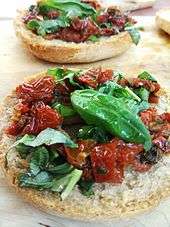
Abbruzzese starters (Italian: antipasti) include:
- Bruschetta: bread spread with salt and oil, sausage, or vegetables such as tomato or zucchini with mozzarella
- Antipasto di fegatini: appetizer from Teramo consisting of chicken livers, onion, peppers, vinegar, sugar, dry wine, pepper, salt and oil
- Mussels of Vasto: mussels stuffed with a mixture of breadcrumbs, garlic and parsley, olive oil, lemon juice, and tomato sauce
- Mussels with saffron: steamed mussels prepared with parsley, onion, bay leaf, white wine, olive oil, and saffron sauce
- Stockfish or salt cod: cod cooked in a pan with potatoes, tomatoes, oil, garlic, parsley, onion, red pepper, salt, and black olives
- Sauce all'aquilana: beef marrow with saffron, eggs, cream and butter
Pasta
One of the region's most popular dishes is maccheroni alla chitarra. The pasta is prepared by pressing dough through a chitarra, creating long, thin noodles similar to spaghetti. It is served with a tomato-based sauce, often flavored with peppers, pork, goose or lamb,[14] accompanied by regional side dishes such as the bean-and-noodle soup known as sagne e fagioli (flavored with tomatoes, garlic, oil, and peperoncini).[15] Other popular pasta dishes are Gnocchi carrati, flavored with bacon and pecorino cheese, and pastuccia (polenta with sausage, eggs, and cheese).
Main courses
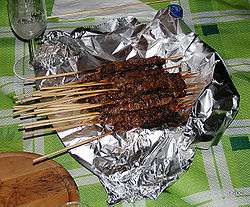
The region features several types of roast lamb and mutton, including:
- Arrosticini: skewered lamb or mutton[16][15]
- Pecora al cotturo: lamb or mutton stuffed with mountain herbs and cooked in a copper pot
- Lamb cooked whole in a bread oven
- Agnello cacio e ovo: a lamb-based fricassee
Other meat-based main coursees include:
- Mazzerella: lamb intestines stuffed with lamb, garlic, marjoram, lettuce, and spices
- Le virtù: a soup from Teramo with legumes, vegetables and pork, usually eaten in the spring at celebrations
- Timballo abruzzese: lasagna-like dish with pasta sheets (scrippelle) layered with meat, vegetables and rice; often served for Christmas and Easter[15]
- Porchetta abruzzese: moist boneless-pork roast, slow-roasted with rosemary, garlic, and pepper[15] It was brought by Abruzzese immigrants to the northeastern United States (particularly Philadelphia), where it is known as "Italian roast pork" or "roast pork."[17][18][19]
- Sagne e fagioli, handmade pasta with beans and tomato sauce
Seafood also plays a role in the cuisine of Abruzzo, especially areas near the coast. Brodetti, a fish broth from Vasto, Giulianova and Pescara, is cooked in an earthenware pot and flavored with tomatoes, herbs, and peperoncino. Other seafood includes scapece (marinated fish) from Vasto. It is the only dish in Abruzzo to use saffron, one of the region's most important products. The fish (often skate) is cut into pieces, floured and browned in a frying pan. The vinegar-based marinade can preserve the fish for 20 to 30 days in wooden containers which are passed from generation to generation.
Breads and pizzas
- Pane di mais (cornbread): primarily loaves and oval, an Easter variant adds boiled potatoes, olive oil, eggs and milk.
- Bread of Senator Cappelli: primarily in the province of Chieti, it has made a comeback.
- Bread ear, named for its ear-like appearance
- Scrippelle: a rustic pancake-like dish from Teramo, similar to a French-style crêpe and served mbusse (in broth) or part of a soufflé with ragù and stuffed with chicken liver, meatballs, hard-boiled eggs, and cheese[15][20]
Rustic pizzas are also common:
- Easter Pizza (Pizza di Pasqua), a rustic pizza with cheese and pepper from the Teramo area
- Pizza fritta, shallow-fried pizza[15]
- Fiadoni from Chieti: a dough of risen eggs and cheese, baked in a thin pastry shell
Salumi
Salumi (singular salume) is an Italian term describing the preparation of cured meat products made predominantly from pork.
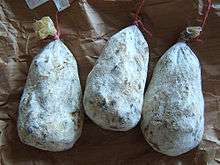
Spreadable sausage flavored with nutmeg and liver sausage with garlic and spices are hallmarks of Teramo cuisine. Ventricina from the Vasto area is made with large pieces of fat and lean pork, pressed and seasoned with powdered sweet peppers and fennel and encased in dried pig stomach. Mortadella di Campotosto (well-known in Abruzzo) is an oval, dark-red mortadella with a white column of fat. They are generally sold in pairs, tied together. Another name for the mortadella is coglioni di mulo (donkey's balls). It is made from shoulder and loin meat, prosciutto trimmings and fat. It is 80 percent lean meat; 25 percent is prosciutto (ham), and 20 percent is pancetta. The meat is minced and mixed with salt, pepper and white wine.
Cheeses
The region's principal cheeses are:
- White cow cheese, a soft cheese made from cow's milk
- Caciocavallo abruzzese, a soft, slightly-elastic dairy product made from raw, whole cow's milk with rennet and salt
- Caciofiore Aquilano, made from raw whole sheep's milk, rennet, artichokes and saffron (which gives it its characteristic yellow color)
- Caciotta vaccination frentana, a half-cooked, semi-hard cheese made from raw whole cow's milk, rennet and salt
- Canestrato of Castel del Monte, a hard cheese made from raw whole sheep's milk, with rennet and salt
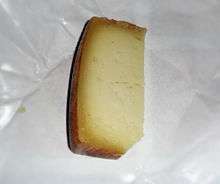
- Caprino abruzzese, made from raw whole goat milk (sometimes with sheep's milk), curd, and salt
- Cheese and curd stazzo, cheese and byproducts obtained from the processing of raw milk from sheep, cattle and goats
- Junket vaccination or Abruzzo sprisciocca, a soft fresh cheese made from raw whole cow's milk, rennet, and salt
- Pecorino d'Abruzzo: one of Abruzzo's flagship products—a mild, semi-hard (or hard) cheese with holes, made from raw whole sheep's milk, rennet, and salt
- Pecorino di Atri, a compact, semi-cooked cheese made from sheep's milk, rennet and salt
- Pecorino di Farindola, cheese made from sheep's milk and pork rennet
- Ricotta, made from the remnants of the coagulation of raw whole sheep's milk, heated after filtration
- Scamorza d'Abruzzo, a stretched curd cheese made from cow's milk, rennet (liquid or powder) and salt
Atri and Rivisondoli are known for their cheeses. Mozzarella (fresh or seasoned) is typically made from ewe's milk; many lesser-known cheeses are found throughout Abruzzo and Molise.
Desserts and sweets
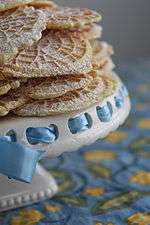
Abruzzo's sweets are well-known:
- Dragée[21] (also known as confetti): sugar-coated almonds from Sulmona
- Torrone Nurzia: chocolate nougat from L'Aquila
- Parrozzo: a cake-like treat made from crushed almonds and coated in chocolate
- Pizzelle (also known as ferratelle): a waffle cookie, often flavored with anise[15]
- Croccante, a type of nougat made from almonds and caramelized sugar, often flavored with lemon[22]
- Calgionetti, cagionetti, caggiunitti, caviciunette: Christmas fritters, sometimes filled with chestnuts or chickpeas and flavored with chocolate or cocoa
- Bocconotti: stuffed sweets often served for Christmas
- Zeppole di San Giuseppe: fried or baked pastries made for Saint Joseph's Day
- Sise delle monache, two layers of sponge cake filled with custard, produced in the town of Guardiagrele in the province of Chieti
Fruits
The region's principal fruits are:
- Agrumi della costa dei trabocchi: coastal citrus (particularly oranges), used for jam and limoncello
- Castagna roscetta della Valle Roveto and Marrone di Valle Castellana: types of chestnut
- Ciliege di Raiano e di Giuliano Teatino: a local cherry
- Mandorle di Navelli: almonds from the town of Navelli
- Mela della Valle Giovenco: apples from the region
- Uva di Tollo e Ortona: table grapes, also used for jam
Alcoholic drinks
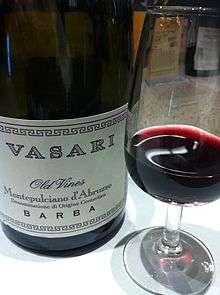
The region's principal wines are:
- Montepulciano d'Abruzzo (red)
- Cerasuolo d'Abruzzo
- Trebbiano d'Abruzzo, the region's wine white. In 2012, Trebbiano d'Abruzzo topped 50 Italian wines.[23][24] Other wines are Montonico, Pecorino, Passerina, and Controguerra.
Liqueurs include:
- Genziana, a liqueur made from gentian root
- Centerba, an aromatic liqueur made from infused herbs
- Aurum: brandy-based Pescara liquor with a 40-percent alcohol content, infused with oranges
- Ratafià, black-cherry liqueur and wine (primarily Montepulciano d'Abruzzo)
IGT wines are Alto Tirino, Colli Aprutini, Colli del Sangro, Colline Frentane, Colline Pescaresi, Colline Teatine, Del Vastese (or Histonium), Terre di Chieti, and Valle Peligna.[25]
See also
- Italian cuisine


References
- "Storia della Cucina Italiana - Ristoranti Abruzzo - La Cucina". www.emmeti.it.
- "Archived copy". Archived from the original on 2014-02-03. Retrieved 2014-01-20.CS1 maint: archived copy as title (link)
- "Archived copy". Archived from the original on 2014-04-29. Retrieved 2014-07-26.CS1 maint: archived copy as title (link)
- "Home - Regione Abruzzo - Dipartimento Turismo, Cultura e Paesaggio". conoscere.abruzzoturismo.it. Archived from the original on 2013-11-14. Retrieved 2014-07-24.
- "ABRUZZO IN TAVOLA". Academia Barilla. Retrieved 6 January 2016.
- Levinson, Debra (2012). Italy Luxury Family Hotels and Resorts. Max Publication, Incorporated. Retrieved 6 January 2016.
- Braimbridge, Sophie (2005). Food of Italy. Allen & Unwin. Retrieved 6 January 2016.
- "Abruzzo, Italy". Delallo. Retrieved 6 January 2016.
- "Archived copy". Archived from the original on 2011-01-12. Retrieved 2016-08-15.CS1 maint: archived copy as title (link)
- Newl, Roddy; s (22 May 2011). "Life in Abruzzo Food & Travel Guide - Liquorice: All Sorts in Abruzzo". Life in Abruzzo Food & Travel Guide.
- "Gourmet Liquorice - AshbyTreats". www.ashbytreats.com.
- Rosengarten, David. "The Cuisine of Abruzzo: Easy to Love, Not So Easy to Describe". Huffington Post. Retrieved 6 January 2016.
- Nicoletti, Amy. "Wild Mushrooms in Italy - Kitchen Tips & Recipe Ideas". Delallo. Retrieved 6 January 2016.
- "Home - Regione Abruzzo - Dipartimento Turismo, Cultura e Paesaggio". conoscere.abruzzoturismo.it. Archived from the original on 2013-11-14. Retrieved 2014-07-24.
- Di Gregorio, Luciano (2013). Bradt Abruzzo. Bradt Travel Guides. Retrieved 6 January 2016.
- "Home - Regione Abruzzo - Dipartimento Turismo, Cultura e Paesaggio". conoscere.abruzzoturismo.it. Archived from the original on 2013-11-14. Retrieved 2014-07-24.
- Hollman, Laurie (November 26, 1992). "Going Whole Hog This Holiday Think Carving A Bird Is Hard? Try This Italian Treat". Philadelphia Inquirer. Retrieved 6 January 2016.
- Evans Sorid, Barbara (November 25, 1990). "Medford Market's Old World-style Roast Pork A Hit". Philadelphia Inquirer. Retrieved 6 January 2016.
- Wilson, Bee (Oct 15, 2010). Sandwich: A Global History. Reaktion Books. Retrieved 6 January 2016.
- "Scrippelle 'Mbusse, Abruzzo -GD Italy.com". www.gditaly.com.
- "Home - Regione Abruzzo - Dipartimento Turismo, Cultura e Paesaggio". conoscere.abruzzoturismo.it. Archived from the original on 2013-11-14. Retrieved 2014-07-24.
- "Abruzzo and Molise Heritage Society". Abruzzomoliseheritagesociety.org. Archived from the original on 2013-03-09. Retrieved 2013-03-12.
- "Archived copy". Archived from the original on 2014-11-10. Retrieved 2014-11-10.CS1 maint: archived copy as title (link)
- "Home - Regione Abruzzo - Dipartimento Turismo, Cultura e Paesaggio". conoscere.abruzzoturismo.it. Archived from the original on 2013-11-14. Retrieved 2014-07-24.
- Massetti, Enrico (2015). Abruzzo. Enrico Massetti.
Further reading
- Teresa, Anna. "Food and Memories of Abruzzo: Italy's Pastoral Land" (Wiley,2004)